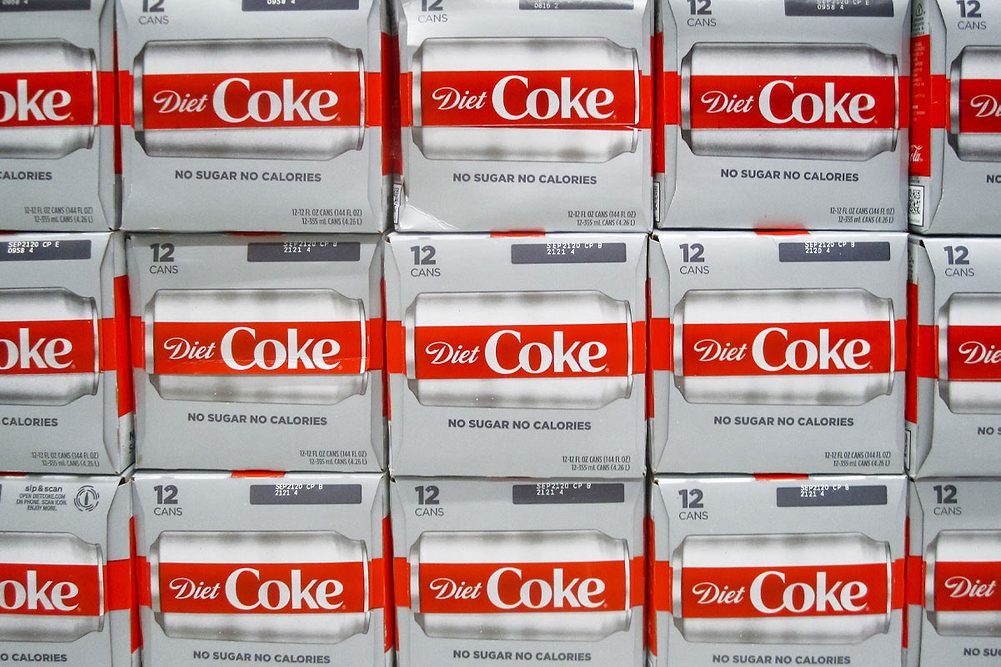ATLANTA — The Coca-Cola Co. is among food and beverage companies bracing for the potential impact of popular diabetes and weight loss drugs on the industry. James Robert B. Quincey, chairman and chief executive officer, said “it is an area that we are very focused on.”
Marketed under brands including Ozempic, Wegovy, Mounjaro and others, such medications may lead to a significant reduction in calorie consumption among the growing population of users in the United States. Mr. Quincey pointed to the Atlanta-based company’s “total beverage strategy,” noting, “we are well positioned to provide choice and to provide options for people’s respective motivations and needs.”
“Sixty-eight percent of our products have low or no calories today, and we continue to invest in innovation and choice…,” Mr. Quincey said during an Oct. 24 call with securities analysts to discuss third-quarter financial results.
Net income attributable to shareowners of the Coca-Cola Co. was $3.1 billion in the third quarter ended Sept. 29, equal to 71¢ per share on the common stock, and up 9% from net income of $2.8 billion, or 65¢ per share, in the prior-year period. Net operating revenues increased 8% to $12 billion from $11.1 billion the year before.
“Our business performance year-to-date gives us confidence that we can deliver on our raised 2023 guidance,” said John Murphy, president and chief financial officer of the Coca-Cola Co. “This is comprised of organic revenue growth of 10% to 11%, which will be led by price/mix and includes positive volume growth. We do expect pricing in developed markets to moderate in the fourth quarter as we cycle pricing initiatives from the prior year.
“There are also a few hyperinflationary markets that will continue to drive price/mix. There will be one additional day in the fourth quarter. We now expect comparable currency-neutral earnings per share growth of 13% to 14%. And based on current rates and our hedge positions, we now expect currency to be an approximate 4-point headwind to comparable net revenues and an approximate 6-point currency headwind to comparable earnings per share for full-year 2023.”
During the quarter, factors including weather conditions, ongoing inflation and geopolitical tensions were among headwinds in some markets, while others showed improvement, Mr. Quincey said.
“We delivered 11% organic revenue growth this quarter driven by positive volume, some pricing actions in the marketplace and carryover pricing coming into the base from last year,” he said. “Volume grew 2% and sequentially improved each month in the quarter with September being our strongest month. Our year-to-date volume growth remains consistent with underlying performance compared to 2019. And overall, our industry remains vibrant and is expanding, and we are executing to capture that growth.
“During the quarter, we gained volume and value share in both at-home and away-from-home channels. Consumer sentiment continues to vary around the world. … We’ve seen some shift to discount channels and switching to private label brands in a few markets and categories. The intensity of this activity was largely the same across Europe compared to the previous quarter but was less pronounced in the US, Australia and Japan.
“In the developing and emerging markets, the picture is more mixed. We’re seeing broadly consumer strength across Latin America, India and in parts of Central and Southeast Asia. On the other hand, consumer confidence in spending has yet to fully recover in Africa and China. Our revenue growth management execution capabilities give us a distinct advantage, and we are leveraging these capabilities to ensure we have the right product in the right package in the right channel and at the right price points to meet consumers where they are.”
Overall, unit case volume increased 2% for the third quarter. Volume in sparkling soft drinks grew 2%. Volume in juice, value-added beverages and plant-based beverage expanded 2%, driven by Minute Maid Pulpy in China, Santa Clara in Mexico and fairlife in the United States. Water, sports drinks, coffee and tea volume grew 1%. Sports drinks grew 3%, with strength in Powerade in Latin America and Europe, Middle East and Africa.
Unit case volume in North America was even, reflecting growth in sparkling flavors, juice and value-added dairy beverages offset by declines in other beverage categories. Price/mix increased 5%, primarily driven by previous pricing actions. Operating income in North America grew 18%, driven by 8% growth in organic revenues partially offset by higher marketing spend.
“In North America, we generated strong organic revenue growth and delivered margin expansion by executing across our total beverage portfolio,” Mr. Quincey said. “We continue to see away-from-home channels outperform at-home channels. Within sparkling soft drink, elasticities are holding up well, and we continue to drive quality leadership with Coca-Cola, Sprite and Fanta.”
He added, “Outside sparkling, BodyArmor and Powerade trends are stabilizing. And fairlife, Core Power, smartwater and Gold Peak generated value share gains.”
In Europe, Middle East and Africa, unit case volume declined 1%. Price/mix grew 19%.
“In Europe, consumers are still facing pressure, and our business was unfavorably impacted by poor weather,” Mr. Quincey said. “Despite these dynamics, we gained value share through strong performances in sparkling soft drinks and tea.”
Unit case volume in Latin America was up 7%, reflecting strong growth across nearly all categories, according to the company. Price/mix increased 15%.
Asia Pacific unit case volume was even, as growth in Coca-Cola trademark beverage and other beverage categories offset a decline in water. Price/mix increased 1%.
Net income attributable to Coca-Cola shareowners for the nine months ended Sept. 29 totaled $8.7 billion, equal to $2.02 per share, and up 16% from $7.5 billion, or $1.74, in the comparable period. Net operating revenues year to date rose 6% to $34.9 billion from $32.9 billion.
Shares of the Coca-Cola Co. trading on the New York Stock Exchange closed on Oct. 24 at $55.64, up 2.9% from $54.08 the day before.





